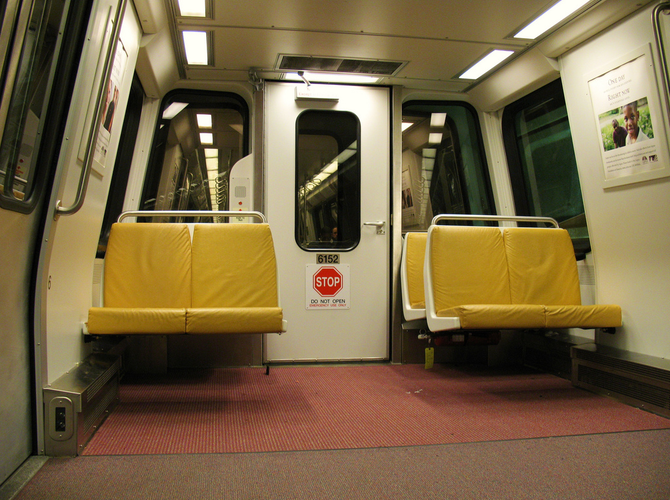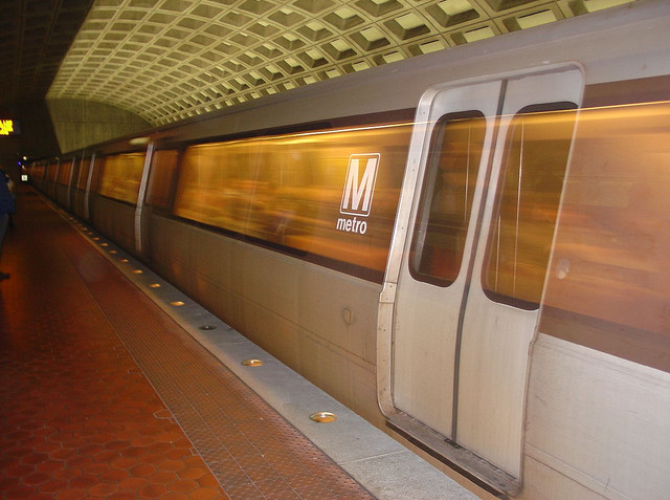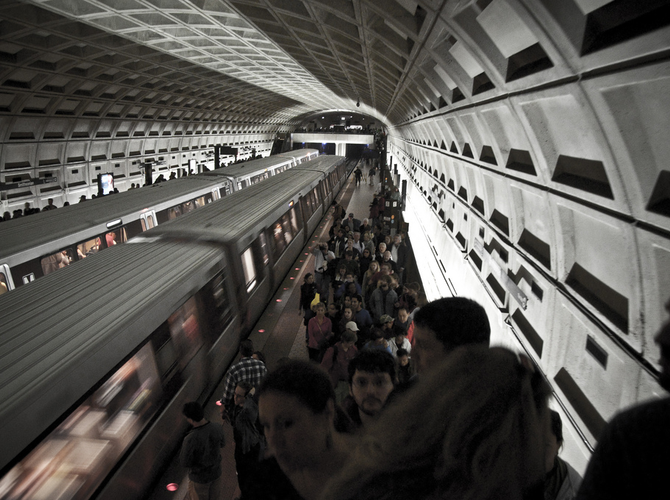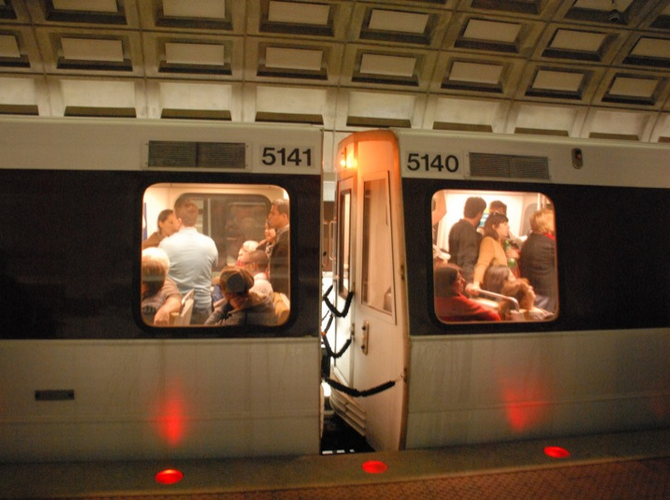10 DC Metro Tips and Tricks
Tip 1: Stand to the Right
During weekday mornings, Metro's main use is for commuters who are late for work. During the late afternoon, the system becomes crowded with riders eager to get home after a long days work. Many of your fellow travelers, during these times, are in a rush to get from point A to point B, and standing on an escalator is just too darn slow.
To accommodate the daily migration of riders anxious to get through the system, an unwritten, but well known rule has emerged: stand on the right, walk on the left. Metro's escalators are wide enough for two lanes of traffic, and in DC, locals know that the left side is for moving traffic, and steady flow. Many riders' biggest pet peeve is the group of tourists, large of small, who are innocently ignorant of this essential law of the land.
While you aren't likely to get honked at or see rude gestures, as you may on the Capitol Beltway, the natives are likely to feel their skin crawl if their way is obstructed. If you are visiting Washington DC and riding on the Metro, you can make everybody's day a little bit brighter by following Tip 1, and standing to the right, leaving the left lane for those who wish to hike up Metro's endless escalators.
Tip 2: Know when to ride
If you are riding Metro to catch a plane or make an important appointment at work, your options for when to ride may be limited. If you have a little bit more leisure, however, some planning can be helpful in making your experience as pleasant as possible. There are several factors to take into account, such as cost of the trip, when the train will be arriving at your station, and how packed the train cars are likely to be.
Metro charges two different rates for any given trip, depending on the time of day. "Peak SmarTrip Fares" are charged on weekdays from opening to 9:30am, and from 3:00-7:00pm, and on weekends from midnight until closing, and range from $2.10 to $5.75 with a SmarTrip card. All other times a lower rate is charged, ranging from $1.70 to $3.50. An additional $1.00 is incurred when using a paper farecard instead of a SmarTrip card for each trip at all times of the day.
During the busiest parts of the day, Metro trains do not generally follow a set schedule. They are often flowing frequently enough that arriving at the station and waiting for the train is only a matter of waiting for a few minutes. In the morning or at night, however, trains tend to follow schedules, found here, much more closely. If you need to catch a plane close to opening or closing, it is worth looking at the schedule and making sure you have enough leeway built into your schedule.
Tip 3: Know where your train is
It would be nice if a train were always at the station waiting for you to arrive, but this is rarely the case. During nights and weekends, and especially during construction or track maintenance, trains can run over 20 minutes apart. To avoid the wait at the station, it can be useful to use tools, such as our Metrorail Train Locator to see when trains will be arriving in real time. Timing your trip to the station can give you more time to relax, or get in those last few minutes of work before leaving the office.
Tip 4: Find a seat near the front
During the busiest commuting hours and busy events in Washington DC, such as the 4th of July, Metro can become absolutely packed, with almost no hope of finding a seat or a comfortable place to stand. Most of the time, however, you can find a place to sit, even on a train that looks pretty full.
Most people wait for the train somewhere around the middle of the station platform. This is convenient, but unfortunately that tends to be the same strategy that everybody used at previous stations as well, and cars near the center of the train will generally be the most crowed. You can often give yourself a more comfortable ride by walking to the end of the platform and getting one of the first couple cars.
Once you get to a platform, take a second to figure out which direction you need to go, and which way the train will be moving. Where two tracks run side by side, trains typically act like cars on the road, running in the right lane. If you have a few minutes to leisurely walk to the front of the train, you will likely find a much less packed car, and, except for the busiest of hours, a free seat.
Tip 5: Save time and money with a SmarTrip card
There are two ways to pay when riding metro: FareCards, and SmarTrip cards. FareCards are paper cards with a magnetic strip which can be purchased at any station. They work well enough, but the many benefits of the SmarTrip card make it a superior option.
The SmarTrip let's you avoid a $1.00 FareCard surcharge on every Metro fare, saving you money. It also also is scanned using a proximity reader, allowing you to scan your card and be on your way with the wave of the hand, saving your time (in fact, you can continue on your way as soon as the gate registers your card; you don't even have to wait for it to close behind the previous rider). As an added bonus, it is accepted by many other transportation options in the DC Metro area, including DASH, Ride On, Fairfax Connector, ART, CUE, Loudon County Transit, Omniride, TheBus, and the DC Circulator.
There are two downsides to the SmarTrip card: it costs $5.00 (but it can quickly pay for itself), and it can be harder to find. If you are taking a short trip to DC, the regular FareCard may make sense, but for anybody who will be here for a while, a SmarTrip card is the way to go. You can purchase online, here, or Metro sales offices and commuter stores, local CVS, Safeway, and Giant stores, and at most Metro stations.
Tip 6: Just catch the next one
Sometimes a train comes by is absolutely packed. You roll your eyes and consider how best to squeeze yourself in. Even though you walked to the front of the train, space is at a premium, and you just don't feel like dealing with so many people. Sometimes this is inevitable and unavoidable; there is a big event going on, or trains are spread too far apart.
On some occasions, however, you look up at the board and see that the next train is only 2 minutes away! It might just be worth the wait, for the chance that this next train will have some empty space. Your prospects will vary considerable depending on the cause of the crowd, but it often doesn't hurt to take the extra time to check.
Tip 7: Take your bike
Much of the Washington DC Metro area is biker friendly, and Metro is no exception. If you ventured a little bit too far, ran into a summer storm, or just want to cover a little bit more ground, this can be an excellent option.
Bikes are not allowed during Metro's busiest hours. This includes weekdays from 7-10 a.m. and 4-7 p.m., as well as the 4th of July and other particularly busy occasions. You are also asked to limit bicycles to four per car, and enter cars using the first and last door of each car.
Tip 8: Study the maps
Knowing where you are going ahead of time is always a good idea, and riding Metro is no exception. Know where you are starting, where you are exiting, and what lines and transfers you'll need before you start your trip. Most directional labels in the Metro system refer to the last station on a line in a given direction. If you are planning to ride the Orange Line, Blue Line, or Silver Line from Rosslyn Station to Smithsonian Station, for example, you are headed in the direction of New Carrollton Station (the eastern most station of the Orange Line) and Largo Town Center Station (the eastern most station of the Blue and Silver Lines).
The traditional metro map is a depiction of relative location, but it does not always show accurate distances. While it probably will not change your travel route, it is worth considering if you are trying to get a sense of how long a trip will take. Often, stations around the National Mall have more separation others in the nearby DC area, but this is not apparent by looking at the DC Metro map.
Tip 9: Keep it clean
The Washington DC Metro system is cleaner than many subway systems due to the WMATA's policies and responsible riders. Let's keep it clean! You may have food or drinks with you on your trip, but there is no eating or drinking allowed on the trains or in the stations. Also, please do not leave trash or papers lying around metro cars. These do get cleaned up at the end of the day, but it is unfortunate to see cars collect unnecessary garbage throughout the day.
Tip 10: Watch those doors
You may hear the warning while standing in a station waiting for your train, telling you that Metro car doors do not operate like the elevator doors you may be used to. They do not re-open when they are blocked, and when they close, they close fairly hard. Take the warning bells seriously and get yourself and your bags away from the doors. The train will not move with a jammed door, but it will not be a pleasant experience either.



